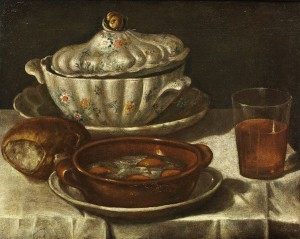
Stillleben mit Deckelterrine, brauner Tonschale, Brot und Weinglas. Öl auf Leinwand, 18th century.
As a child, my first memory of a soup is Oxtail. Not so much for its flavor—though it is delicious—but for the adventure at my grandmother’s side.
In late winter, after Christmas and before Lent, I would often spend a weekend at my maternal grandparents’ house. I delighted in the quietness and solitude that their home afforded.
When I was too small to help prepare foods, I would sit at grandma’s side on the bench to the kitchen table and chatter as she sliced and diced. So much did I hunger for her love that even when she chopped the onions I would not move away, no matter how much the stinging created tears.
Often, early in the morning before she even began preparing the vegetables for soup, we would hop in her car and head for the local butcher’s. Walking through the shop door next to my grandmother, I would feel slightly nauseated by the strong feculent scent and visual display of raw bloodied meats. My dizziness was exacerbated by the whirring heat venting out from under the glass cases as I stood in my snowsuit.
This particular butcher’s shop fed the ethnic appetites of the surrounding communities just outside Detroit. It was a time when religious affiliations mattered little and moral values spoke volumes. His display of goods was not nearly as polite as the governmentally regulated meat counters we see today. Besides the usual wurst’s, burger, and chops, I would stare at rows of blue-grey tongues of beef, plump veined mountain oysters, puddles of purple bloodied livers in silver trays, wrinkled kidneys and tripe, sinewy pig’s feet, and whole plucked chickens. There were other pieces of animal anatomy available for purchase, though I never ventured that far down the display case, staying instead near my grandmother’s side.
Grandma could ask for any number of meat items, but for this soup she would ask for eight joints high on the tail—“they are meatier you know” she would say to no one in particular. The butcher would nod and then disappear through double white doors. After a few minutes and multiple hard whacks he’d return with several joints on a reddish-brown sheet for grandmother to inspect. Her approval resulted in the bundle being wrapped in white paper and tied with string. If the butcher shop was not too busy, I would often get my own little trussed bundle.
Upon returning home she would set about preparing the vegetables with me dutifully at her side. Once the slicing and dicing was completed, she would pull out a large brushed aluminum stock pot, the bottom darkened with use, and, setting it on the back unit, would tip it to one side as she lit the burner with a wooden match. Adding the stock that had been thawed the night before, she would set about cooking our supper.
This recipe tastes very much the same as when my grandmother would make it. Oxtails in the 1950s were considered marginal foods and very inexpensive. Today they cost almost as much as sirloin. Though expensive, try to use them rather than stewing beef, for they add a unique flavor to the soup that cannot be duplicated.
Oxtail Soup
64 oz. beef stock (8-10 cups): Use homemade, prepackaged or paste dissolved in water. Bouillon cubes may be used but they make the broth excessively salty and often bitter.
6-8 beef tail joints
½ large sweet Vidalia onion, about a cup, diced and divided in half
2 celery stalks with leaves, diced
1 large carrot (unpeeled), diced
3 whole cloves or ¼ tsp. ground
½ tsp. salt (omit if using paste or bouillon)
¼ tsp. allspice (up to ½ tsp. to desired taste)
1 bay leaf or 1/8 tsp. ground
1-12 oz. can diced tomatoes, or better yet, home canned tomatoes
1-12 oz. can tomato juice
½ c. dry barley, for thicker soup use up to 1 c.
1-10 oz. bag frozen peas and carrots or ¾ c. each fresh, do not use peas in pods.
Place stock in large soup pot; add beef tail joints, ½ of diced onion, celery and carrot. Bring to boil, turn down heat and simmer until meat is tender, about two hours. Remove joints to cool. Meanwhile, puree stock. Remove meat from joints, discard bone and return meat to soup. Add remaining ingredients, including onion, bring to a low boil and simmer until barley is tender. Leftover soup thickens; use tomato juice, white wine, or beef broth to thin, do not use water.
I rarely use the salt suggested in this recipe because of the sodium content in store-bought stocks and tomato juice. You can add fresh ground pepper to the soup when serving if desired, but avoid adding it to the soup when it is cooking. The pepper when added during cooking seems to dull the flavor of the allspice and cloves.
Brown rice can be substituted if you don’t like the nutty taste or chewy texture of barley. I have also used wild rice and loved it! Allow wild rice to cook for 30 minutes after you puree the soup and before you return the meat to the pot.
















